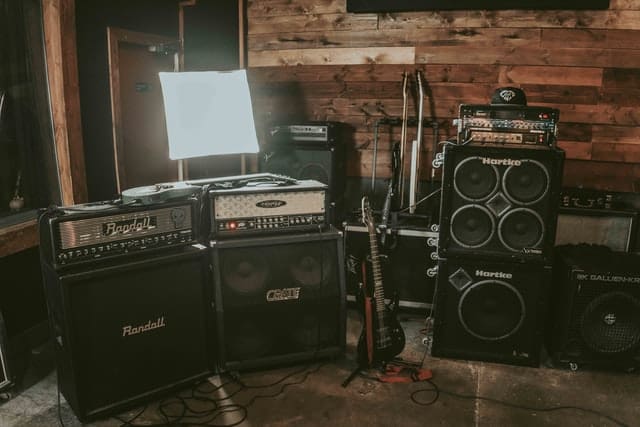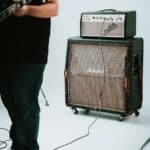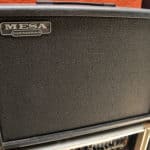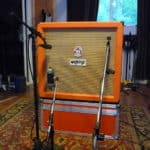Guitar players have a lot of issues to think about, to properly maintain their style they not only have to be aware of their instrument but also the equipment, pedal effects, power supplies, amplifiers, amp heads, and even cabinets among other gears.
With respect to the tone, the amp plays a relevant role not only due to its unique sound but also because of the tone of the speakers within it.
In a guitar amp, speakers are the most defining component concerning the equipment’s tone. Although everything matters, a speaker will be way more influential to the final outcome rather than cabinets.
Maybe you are wondering how can this be possible, if speakers are the most important component regarding the tone, what about the cabinets? Don’t they matter?
What about the instrument used?
These and more questions will be answered in this article.
Through this text, I will try to clarify every existing doubt about this interesting topic, if you feel confused don’t worry, I’m here to help you! In the end, you will know everything about this issue.
How important are speakers for the tone of an amp?
First of all, it is important to state that amp speakers are way different than hi-fi speakers or studio monitors.
The main point is that the latter are designed to reproduce another kind of sound rather than a guitar signal, that’s why they do not respond efficiently when you plug in an instrument.
When talking about tone, speakers are one of the most important factors as regards a guitar amp sound.
That is because speakers work to color the tone of the amplifier plus are involved in the dynamic response of the equipment.
What is more, different speakers vary in loudness which means that two amps with the same wattage could produce dissimilar volumes.
Another remarkable aspect to bear in mind concerning the tone is the resonance produced by the speaker, depending on how the frequencies resonate the tone will be modified.
Why could same size speakers sound different?
Like with everything related to music equipment, this has to do with the gear construction, non-identical materials provide different outcomes.
We have already mentioned that even the same power source would result in distinct loudness.
Moreover, the components employed in their building could vary from speaker to speaker, some of them are crafted by using superior quality parts whereas others use standard or basic pieces.
As a result, you will notice a difference in terms of sound quality and tone.
Besides, speaker stiffness should be considered, although the speakers are identical in size, this feature varies among them. As a consequence, the output obtained also changes.
What are the factors that define the tone of a speaker?
Apart from the previously mentioned aspects, more factors determine how the tone of a speaker will sound.
Due to that, I will leave a list describing the most important features to bear in mind.
Sensitivity or Sound Pressure Level
Sometimes happens that amplifiers with the same wattage produce unalike output volume levels, and that’s strictly bounded to the speaker’s sensitivity.
To measure the sensitivity of an amp you will have to feed it one watt and calculate the sound pressure level at a one-meter distance from the amp, guitar speakers usually measure between 93dB and 103 dB.
What determines the sensitivity of a speaker is the mass of the cone and the length of the coil plus the magnet’s strength.
The lower the mass and the stronger the magnets, the higher the sensitivity.
Power handling
This aspect is usually confused with loudness but, although there are connected, both factors are not the same so shouldn’t be matched.
For instance, the logic will tell you that a 50-watt speaker will suit perfectly with a 50-watt speaker but that is not the case because transient peaks tend to exceed the power rate of an amp.
That’s why it would be safer to use a higher wattage speaker or two 50-watt speakers.
What is more, when speakers are pushed to the limit they don’t perform properly, colorless tone, loss of low frequencies, and unpleasant distortion are some of the resulting sound problems.
Besides, this not only will produce changes in sound but also could drastically damage your equipment.
If the gear is overheated for a long time, the materials in the coil position can be ruined plus pushing the speaker beyond the limits can cause them to blow up.
Resonance
Contrary to what most people think, speaker cones have their own resonance which is truly important when defining the voicing of it.
Some players prefer bass speakers due to they produce a lower resonant frequency, resulting in warmer tones.
On the flip side, some others are more fond of coated-edges cones, by doing that you can have a more controlled response because you will be limiting the cone excursion.
That process is known as doping, doped speakers are common among rock guitar players that look for higher frequencies and more volume.
Cones
Most guitar speaker cones are made from paper pulp, however, as they vary in stiffness they will provide non-identical tonal options.
Nowadays, most manufacturers tend to build corrugated cones to increase their stiffness without increasing their weight.
That is because guitar players are inclined to force the speaker in order to overdrive harder the signal.
Ribbed speakers came to solve that problem, reducing their breakup and preventing the cone to warp.
Nevertheless, as low-power equipment is on the trend currently, lots of guitarists prefer smooth cones.
These components provide a really interesting sonic feature, smooth cones are popular for a more organic, vintage tone plus less sharp high frequencies, and quicker breakup.
Magnets
We can find three different types of magnets employed in speaker’s construction: alnico, ceramic, and neodymium magnets.
From the early 50s, alnico magnets were the most used in amps but as the price of the materials got excessively higher, manufacturers moved to ceramic magnets.
Defining the performance of each kind of magnet would be a tough task due to they will act differently regarding the components in the whole speaker.
Having said that, I would define the alnico magnets as soft low-ended, and prone to chime at high frequencies.
Regarding ceramic magnets, they produce quicker lows and more presence at the midrange frequencies plus a punchy tone but fewer highs.
Last but not least, we have neodymium magnets, these are hard to define, they are thought of as a combination between both alnico and ceramic magnets.
Is the quantity of speakers on a cabinet a tone-defining factor?
By adding more similar quality speakers you will get a louder output, you will be doubling the sound intensity resulting in an increase in loudness of 3dB plus more air displacement within the room but I wouldn’t say that more speakers define the tone.
Perhaps the size of the cabinet may define a bit the tone and could acoustically modify it depending on the size of the room as well but speakers are more related to determine the tone.
To take profit from the acoustic tonal options while recording is common to mic just one speaker, in some cases two different mics at different spots but not more than that.
This could be because speakers might sound disparately within the cab and according to the place in the room so the mics can pick up dissimilar tones.
Are speakers more important than cabinets for an amp’s tone?
When referring to the amp’s tone, speakers are in charge of coloring and modeling the signal way more than cabinets.
However, as you may know, every single component matters in building up the characteristics of the equipment.
What I mean to say is that, although speakers tend to be more influential when crafting a certain or specific tone, matched to distinct cabinets could have variations concerning the tone.
For instance, the same speaker won’t produce the same output with a 1×12 cab as 2×12 cabinets, again speakers are the most defining factor but the size of the cabs will also affect some frequencies.
Most popular guitar amp speakers and their tone
As you may notice, there is a vast range of speakers available in the market, and each of them presents its distinctive sound.
For you to have a better idea, I will leave you a list of the best and most popular guitar amp speakers, I will also explain how they sound and what sort of guitar players prefer each of them.
Celestion Vintage 30
Celestion is one the most famous speakers in the world, this British 12 inches speaker has built the British rock sound through history.
With a power rate of 60W, you will be able to play at clubs or small gigs as much as for large concerts connected to bigger cabinets.
This speaker is the modern version of the Celestion Blue speaker from the 60s. As regards its tone, it will give you a clear and crisp sound as the result.
Celestion G12H-75 Creamback
The same way Celestion Blue was reimagined and the Celestion Vintage 30 appeared, G12H is a reinvented version of the G12-M Greenback speaker, a pretty famous gear used during the 60s and 70s in the British music industry.
As it comes with a 12 inches diameter cone plus a 75W power rate, this speaker provides a thick low-end sound plus a proper resonance commonly used by rock music guitar players.
Eminence Ragin Cajun Patriot Series
On the flip side, we have this 10 inches speaker which produces that classic American southern sound.
With a maximum 75W power rate and a low weight (less than 7 pounds), you will have light equipment which can easily be with you.
Although this speaker is smaller than the ones above, you will be amazed by its performance.
You can expect a well-defined low-end from this speaker with a thick and dusty tone that will suit perfectly jazz, blues, and even country music.
Eminence 820H Patriot Series
As you may notice, speakers come in several sizes, we have 12 and 10 inches gears but in this case, Eminence 820 is a bit littler than the ones discussed earlier.
With a diameter of 8 inches, this speaker also belongs to Patriot Series, as a result, you can distinguish the American sound on it.
Although Eminence 820H consists of a low-wattage speaker just of 20W, it is a really good option for playing in small rooms.
These speakers are selected by fewer people because as they don’t have much power, they are perfect for your practice amp or even for recording at home!
Electro-Voice EVM12L
As a final point, we have a speaker which presents higher quality than the others. EVM12L is a top-notch gear commonly used by famous musicians such as Zakk Wylde (he has his own signature guitar speaker) at their stadium concerts.
This is a 12 inches speaker which will cover every range you might require, EVM12L has a 200W power rate so you won’t have any volume issues. Concerning the sound, it provides a powerful, strong output, and due to the high amount of headroom it has, you can notice how the definition increases.
Is upgrading the speaker of your amp worth it?
By replacing the speaker of your amp you won’t always get an upgrade, what I mean to say is that it always depends on the amplifier you own.
For affordable amps, it will surely be a great upgrade because it is a component that manufacturers tend to save on.
Replacing a low-quality part in your amp will always bring you a better and superior result in terms of sound. But in the case of high-ended amps, they already come with a high-quality speaker.
Consequently, changing the speaker on it might be a new tonal option available in your amp rather than an upgrade.
Replacing your speaker could also be a way of searching for a particular tone different than the one presented by your current speaker.
Are guitar amp speakers the same as hi-fi audio speakers?
As the name evokes and although it may sound silly, guitar amp speakers are intended to work with the sounds produced by guitars.
Guitar audio speakers are tuned to focus on specific frequencies which are important to the guitar, that set of frequencies is shaped and molded by the speakers.
Hi-fi speakers are designed to give a flat frequency response, they are intended for a different use so although it is possible, plugging a guitar and running it through them will have a far dissimilar output result.
Therefore, you should know that in no way guitar amp speakers are the same as hi-fi speakers, both are created for unrelated uses plus their performance is not alike.

Hello there, my name is Ramiro and I’ve been playing guitar for almost 20 years. I’m obsessed with everything gear-related and I thought it might be worth sharing it. From guitars, pedals, amps, and synths to studio gear and production tips, I hope you find what I post here useful, and I’ll try my best to keep it entertaining also.





